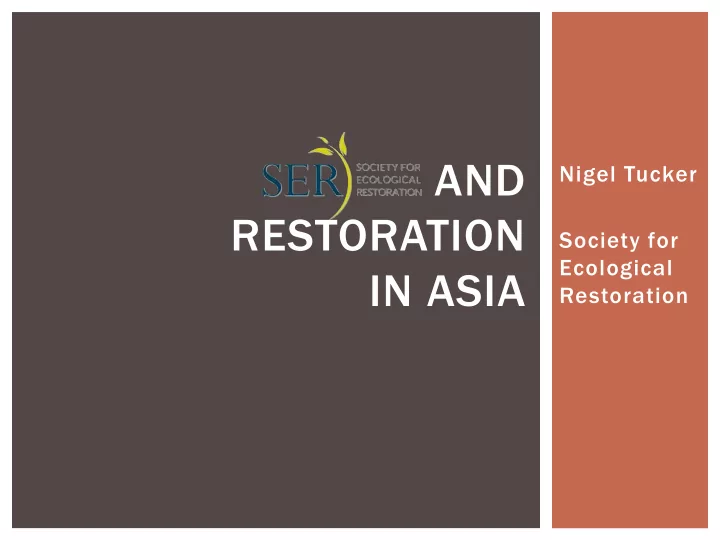

AND Nigel Tucker RESTORATION Society for Ecological IN ASIA Restoration
SER AND RESTORATION IN ASIA Roadside Restoration Project - January 1988
SER AND RESTORATION IN ASIA RRP - Same Site – October 2013
SER AND RESTORATION IN ASIA Donaghy’s Corridor - 1200 x 100m Wildlife Corridor
SER AND RESTORATION IN ASIA Donaghy’s Corridor - January 1995 Planting
SER AND RESTORATION IN ASIA Donaghy’s Corridor - Same Site – October 2013
SER AND RESTORATION IN ASIA Pipeline Construction – PNG - November 2012
SER AND RESTORATION IN ASIA Pipeline Construction – PNG - October 2013
SER AND RESTORATION IN ASIA Pipeline Construction – PNG - November 2014
SER AND RESTORATION IN ASIA About SER SER has over 2500 members in 14 chapters across the USA, Australasia, Europe, Canada and Nepal Produce a quarterly journal “Restoration Ecology” and other resources , aimed at researchers, practitioners and policy makers Members throughout Asia - formation of an Asian SER Chapter is under discussion
SER AND RESTORATION IN ASIA SER Australasia (SERA) Australasian chapter formed 2011, includes members from New Zealand/New Caledonia Australia/New Zealand National Restoration Standards were released in 2016 (http://www.seraustralasia.com/pages/standards.html) Standards are critical to outcomes and provide enhanced security for public and private investment
SER AND RESTORATION IN ASIA What is Restoration? “The process of repairing damage caused by humans to the diversity and dynamics of indigenous ecosystems”. (SER) The amount of repair undertaken varies depending social and ecological factors Together, Asian societies and ecology produce a spectrum of approaches between natural regeneration, ecological restoration, rehabilitation, agroecology and forestry
SER AND RESTORATION IN ASIA Techniq ique ue Descrip criptio tion Natural Regeneration No inputs, requires forest close by & knowledge of weed ecology No specific focus but maintains options Suited to protected area margins Ecological Restoration Planting of indigenous native species to create new habitat Focused on biodiversity outcomes Suited to wildlife corridors, riparian zones , protected areas Rehabilitation Planting a mixture of native species and benign exotic species Focused on soil stabilisation Suited to mine-sites, industrial developments Agroecology Planting mixtures of native and exotic species for food, fibre, medicine (agroforestry) Emphasis on agriculture and biodiversity Suited to village land-holders Forestry Planting exotic species only Focused on commercial returns Suited to large areas on low-value soils
SER AND RESTORATION IN ASIA Successes Forest Restoration Research Unit (FORRU) Thai knowledge and experience being transmitted to neighbours – Laos, Cambodia Undertakes restoration, research, village extension and training Published 3 manuals on restoration planning, implementation and monitoring Derives income from private sponsorships Success partly due to Chiang Mai University involvement
SER AND RESTORATION IN ASIA Restoration Challenges Forest Fragmentation Poverty Biodiversity Decline Land-use, Conflict and Climate Change Tenure Invasive species Regulatory Frameworks Performance Standards
SER AND RESTORATION IN ASIA Imperata Grasslands 4% of the Asian continent is affected Indonesia and India together have 16 million ha, Sri Lanka (23%tla), Philippines (17%tla), Laos, Thailand and Burma (4%tla each) Maintained by fire and avoided by agriculture Opportunity to apply a range of restoration options
SER AND RESTORATION IN ASIA Successful Forest Restoration can transform landscapes and livelihoods, if; Goal(s) are clearly stated Government forms effective partnerships with the private sector and landholders/participants All stakeholders are engaged Projects are monitored and evaluated across a range of measures “You cannot value what you don’t measure” (TEEB)
Recommend
More recommend